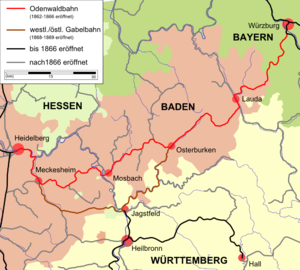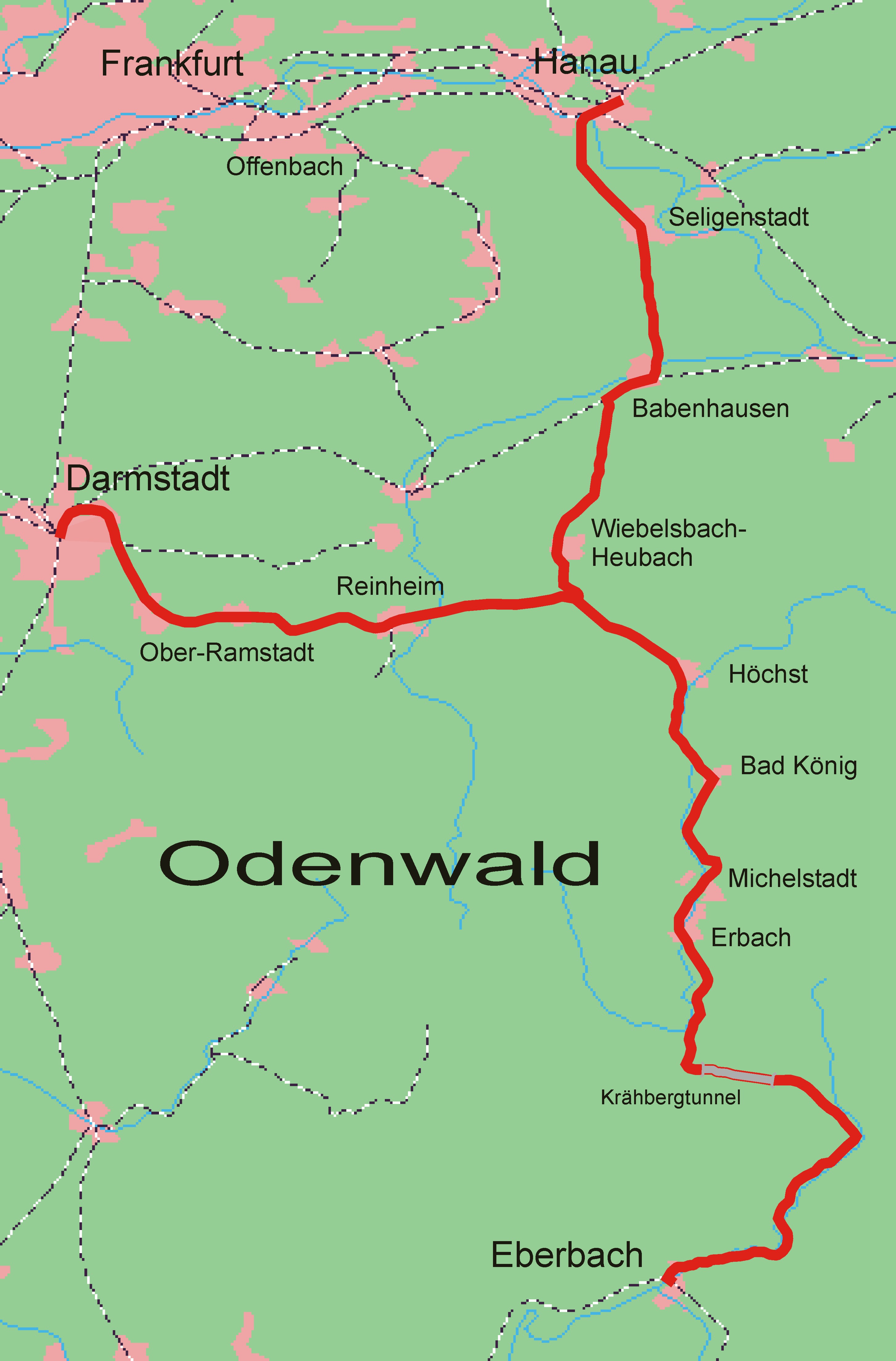Odenwald Railway (Baden)
The Odenwaldbahn (also Badische Odenwaldbahn to distinguish it from the Hessian Odenwald Railway ) is a formerly continuous Baden railway mainline.
It led from Heidelberg Neckargemuend and Mecke home through the small Odenwald Waibstadt, and Mosbach, Osterburken and Lauda to the Bavarian Würzburg.
History
Formation
The plans to build a railway network in the Grand Duchy of Baden mid-19th century initially focused on the construction of the Baden Mainline as north-south route through the Upper Rhine Valley from Mannheim to Basel and to connect the Lake Constance area around Konstanz. In contrast, the north-east of Baden was disregarded. Therefore were collected always louder demands from the 1850s, these poor areas in southern Odenwald, in the land and in the Tauber Valley ( commonly derided as the Baden Siberia) to the railway network to connect. While leaving a railway track in this area, if at all, only expect a small return, but you saw in railway construction next to the traffic-related benefits also an investment in order to promote this favored land.
Apart from bathing and the Kingdom of Bavaria had an interest in the construction of a railroad between the Palatinate and Lower Franconia, since such a railway provided a link of the Bavarian heartland bypassing Württemberg with the then Bavarian Palatinate. However you wanted in Bavaria a route along the River Main on Wertheim, Miltenberg, Amorbach and Eberbach, Baden during preferred a more southerly route via Mosbach. After lengthy negotiations, both countries agreed in 1862 on a route over Mosbach. The contract also included the construction of a railway bridge over the Rhine at Mannheim, so that a direct railway line from Würzburg originated in the Palatinate. For the construction of the line shell limestone rock was broken out of the Kallenberg.
The Baden Odenwald railway was opened in two stages. Heidelberg on Neckargemuend Meckenheim Neckarbischofsheim, Aglasterhausen and Neckarelz to Mosbach on October 23, 1862 and from Mosbach to Würzburg via Osterburken and Lauda on August 25, 1866 The construction of the second section had delayed due to the fighting in Tauberbischofsheim during the German war.
The routing of the Odenwaldbahn presented on the section between Neckargemuend and Mosbach a special dar. Instead of a route in the Neckar valley on Eberbach had decided in favor of a gradient richer and thus operationally problematic tour of the Elsenz and Schwarzbach about Meckenheim, Neckar Bishop Home and Aglasterhausen because between Neckargemuend Eberbach and the Grand Duchy of Hesse reached to the river Neckar, so that a railway line in the Neckar Valley by Hessian territory should have led. However, a route over foreign territory was not desirable.
Shortly after its completion, the Odenwaldbahn was connected by two strands with the Württemberg railway network, from Meckenheim Sinsheim to Jagstfeld ( "western fork lift", 1868/1869 opened ) and Jagstfeld Osterburken ( "East fork lift", 1869 opened ). To open up the Tauber Valley, the Tauber Valley Railway was built following the Odenwaldbahn in the years 1867-1869 according to Wertheim and Bad Mergentheim.
Further development
As was already expected during construction of the route, the traffic developed on the Odenwaldbahn only weak. She could not meet the expectations set for them both in verkehrlicher than in structurally and politically. However resulted from the combination of the track with adjoining railway lines new transport links, which exceeded the importance of combining the Palatinate and Lower Franconia in the course of development. Thus, the individual sections of the Odenwaldbahn developed very differently:
Heidelberg Neckargemuend
This section is assigned to the Neckar Valley Railway in 1879 opened Heidelberg Heilbronn today and serves the passenger and freight traffic between the Palatinate and the Stuttgart area. The route is double track and electrified since 1972. Since 2003, the section is part of the S- Bahn Rhein Neckar. With commuter trains of the relations Homburg - Kaiserslautern - Mosbach ( - Osterburken ) and Heidelberg - Epping as well as guidelines for the relations Heidelberg - Mosbach- Neckarelz - Heilbronn and Heidelberg - Meckenheim - Heilbronn is very crowded in the transport of this section.
Neckargemuend - Meckenheim
Operationally, this section forms a unit with the western fork train to Jagstfeld. In addition to the Neckar Valley Railway, this results in a second connection between Heidelberg and Heilbronn. Beside the subway trains to Epping. The route is double track and electrified since 2009. S -Bahn trains to Epping (S 5 ) and after Aglasterhausen (S 51).
Mecke Home Neckarelz
After the opening of the Neckar Valley Railway where this section very quickly lost importance because the through trains were now out on the operationally effective Neckar Valley Railway. Of all the sections of the Odenwaldbahn this had the least traffic- volume and was virtually relegated to branch line.
With the destruction of the Neckar bridge at Obrigheim 1945, the section Mecke Home Obrigheim became the branch line; a restoration of the bridge over the Neckar failed due to their low traffic-related significance. As the demand between Aglasterhausen and Obrigheim the conversation of the two tunnels on this section was very small and expensive, this section was founded in 1971 shut down and dismantled in the aftermath. For the stretch Meckenheim - Aglasterhausen following the Schwarzenbach, became common in the vernacular, the term Schwarzbach Valley Railway one.
Around 1980 announced the German Federal Railways, adjust the route completely. This would have meant that the existing since 1900 Krebsbach Valley Railway, which branches in Neckarbischofsheim north and leads up to Hüffenhardt would have been without connection to the rest of the rail network. Therefore, took over in 1982 the West German transport company ( SWEG ), since 1963 manager of the Krebsbach Valley Railway, and the operation between Meckenheim and Aglasterhausen. During the second stage of the S- Bahn Rhein Neckar, the route was taken over again by Deutsche Bahn in August 2009, electrified and expanded for the S -Bahn operation. Passenger traffic on the cancer roller coaster brook was set in this context, since it would then no longer economically viable according to a statement of SWEG can be. The line S 51 operated a connection Heidelberg Mecke Home Aglasterhausen.
Neckarelz - Osterburken
This leg has now only regional importance as part of the S- Bahn Rhein Neckar. The route is double track and electrified since 1975.
Osterburken -Würzburg
Along with the route between Stuttgart and Heilbronn- Osterburken results in a traffic relation from Stuttgart to Würzburg and thus linking the regions of Stuttgart and Heilbronn to the major north -south link Würzburg- North Sea ports. The route is double track and electrified since 1975.
Of all the mentioned sections, this had the most important meaning. For a long time reversed long-distance trains on this section. However, since he is very curvy and thus does not allow too high speeds, he lost after the Second World War - in particular in the course of the construction of high-speed rail lines - in importance, so that was set in 2001 with the Interregio Rennsteig the last remaining long-distance train. However, the route Osterburken -Würzburg continues to be used for numerous freight trains of the North-South relationship. The transport had a rather low priority. Thus, all stations were in the 1970s between Osterburken and Lauda due to the sparse population temporarily abandoned. From the turn of the millennium were reactivated some of them though, are on weekdays but served only by a few regional trains, such as the important for the student traffic stations Rosenberg ( Baden), Eubigheim and Boxberg / Wölchingen.










